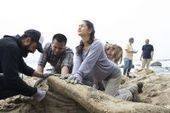Volunteers chop up a reeking whale carcass to salvage bones as vital learning tools for underprivileged Bay Area students If there's anything as enjoyable to Dan Sudran as sawing through the stinking blubber of a whale carcass and extracting bones from the gooey tissues, it would be showing the results to children. Sudran, the founder and director of the nonprofit educational group Mission Science Workshop, led a team of about 20 volunteers Friday in the salvage of a 25-foot long humpback whale that had washed ashore next to the Pigeon Point Lighthouse. "There was a lot of evidence that it was attacked and killed by orcas," said Sue Pemberton, curatorial assistant in the department of ornithology and mammalogy at the California Academy, which is a member of the Marine Mammal Stranding Network. "Mmmm, peanut butter and jelly," cracked another to Westberry, who plans to extract oil from the fat and use it for chemistry lessons on combustion, light and heat, which is what whale blubber was historically used for. Sudran said humpback skeletons are especially fascinating because it is clear when they are examined that the species was once a land animal, with legs, arms and hands, the remnants of which are particularly evident in the flipper bones.
Research and publish the best content.
Get Started for FREE
Sign up with Facebook Sign up with X
I don't have a Facebook or a X account
Already have an account: Login
Coastal management and restoration of our planet's coastlines with a particular focus on California, Louisiana and the Pacific. Emphasizing wetland restoration, aspects of agriculture in the coastal plain, fisheries, dealing with coastal hazards, and effective governance.
Curated by
PIRatE Lab
 Your new post is loading... Your new post is loading...
 Your new post is loading... Your new post is loading...
|











Ahh...the stench of a rotting marine mammal. Good times.